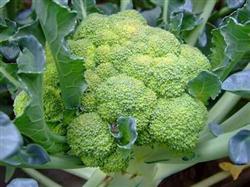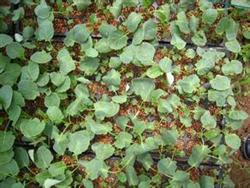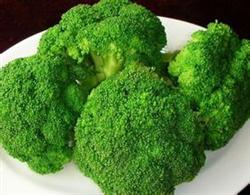How to plant broccoli for high quality and high yield?

Broccoli, also known as broccoli, green cauliflower, with fleshy, fat and tender flower branches composed of flower balls for food, complete nutrition, high nutritional value, crisp and tender texture, refreshing and palatable, loved by consumers. Broccoli likes warm and cool climate and humid environment, avoids heat and drought, and is not resistant to frost; the optimum temperature for seed germination is 15 ℃, the optimum temperature for plant growth is 20 ℃, and the optimum temperature for rosette formation is 15 ℃ and 18 ℃, and the flower head is underdeveloped. It is easy to cultivate and is an excellent vegetable species to make full use of winter fallow land after harvest. Broccoli as a new vegetable variety, in order to obtain high quality and high yield, we should understand its characteristics and requirements of growth and development, and master cultivation techniques: first, variety selection of broccoli can be divided into early, middle and late ripening types according to maturity. At present, most of the broccoli varieties cultivated in China are introduced from the United States, Japan and other countries, and the suitable varieties can be selected according to different cultivation seasons. Summer and autumn production should choose heat-resistant, early-maturing varieties, such as green wind, pearl green, inner green, big green, etc.; winter production should choose cold-resistant, compact plant type, flower ball compact mid-mature or mid-precocious varieties, such as Green Ridge, Fuji Green, Autumn Green and so on. Second, sowing and raising seedlings in winter broccoli should first select varieties with wide applicability and strong cold tolerance, sowing in a pre-prepared seedbed or raising seedlings in a nutrition bowl. The sowing amount is 20 / mu and 25g / mu. 1. Preparation before sowing: broccoli can use nutrition cup or seedling bed to sow and raise seedlings. In order to raise seedlings with a nutrition cup, we should first prepare nutritious soil, select 3 parts of garden soil or paddy soil that have not planted cruciferous vegetables within three years, add 1 part of fully mature farm manure, and then add 1 kg of calcium superphosphate and 0.6 kg of potassium sulfate per cubic meter of nutrient soil, mix well and fill the cup. To raise seedlings in a nursery bed, a loam plough with convenient drainage and irrigation should be selected to turn through the sun. A border with a width of 1.5m / m and a height of 20m / m should be used as a seedbed. Each square meter of seedbed should be applied with rotten organic fertilizer 10ml 15kg and a certain amount of phosphorus and potassium fertilizer. After application, the fertilizer soil should be mixed evenly and raked and leveled. 2. Sowing: sowing seedlings with nutrition cup, sowing nutritious soil before sowing, sowing 1 grain in each cup, covering thin soil after sowing, spraying herbicide; seedling in seedling bed, mixing seeds with a certain amount of fine sand in advance and then sowing, sowing amount of 4 grams per square meter (that is, seedlings of 5 square meters can be planted in one mu), covering 0.51 cm thin soil after sowing, spraying herbicide, and then covered with a thin layer of rice straw. The weather is high-temperature and rainy in late summer and early autumn, no matter the nutrition cup or seedling bed, it is necessary to cover the sunshade net to protect against rain. 3. Seedling stage management after sowing: pay attention to watering after sowing, often keep the soil moist, the seedlings can be raised in about 3 days, and the straw should be removed in time. When raising seedlings in summer, special attention should be paid to the prevention and control of yellow striped beetles and cabbage insects at seedling stage. The shading net was removed 10 days before transplanting, so that the seedlings could fully see the light and refine the seedlings. After 30 days of sowing, the height of the seedling is about 15 cm, and it can be planted with 6 true leaves. Spraying insecticidal and seedling-killing agents on the seedbed before planting. Third, select the land with good drainage and irrigation conditions before planting, ploughing and preparing land for 10 days before planting, and deep application of base fertilizer in ditches. The amount of base fertilizer used is 2500 kg per mu of rotten pig and cow manure, 25 kg of compound fertilizer and appropriate amount of boron fertilizer and calcium fertilizer. Soil preparation after the border, the border north-south direction, generally package ditch 1 Mi 1.2 meters double row planting, border height 20 Mel 30 cm. The planting row spacing is 40 cm × 50 cm, and there are about 2500 seedlings per mu. 3. Field management 1. Watering: broccoli likes fertilizer and water, and avoids inflammation, heat and drought. Generally, it should be watered once every 7 days and thoroughly watered. It should be drained in time in the rainy season so as not to cause rotten roots. 2. Topdressing: nitrogen fertilizer is the main type of topdressing, stage and timely topdressing. After 20 days of planting, 10 kg of urea was applied per mu; when the plant had 15 leaves, 10 kg of urea was applied per mu; when the plant had 21 leaves, 5 kg of urea, 30 kg of calcium magnesium phosphate and 3050 kg of potash fertilizer were applied per mu. Heavy fertilizer was applied during the rosette formation period, compound fertilizer (preferably organic compound fertilizer) 25ml / mu was used, magnesium, calcium, sulfur, boron fertilizer, etc., were added, and 0.1% borax was sprayed 2mi / mu for 3 times. After the flower head is harvested, the varieties with strong germinating ability of opposite lateral branches need to continue to be fertilized and watered. Each time the lateral flower heads were harvested and fertilized once. 3. Ploughing and sprouting: loosen the soil and weed before fertilization, and cultivate the soil after fertilization. For the special varieties of the main bulb, the lateral buds should be erased before the main bulb is harvested, and the varieties of the main and lateral bulbs should be selected to keep 4 strong lateral branches to erase the thin and weak lateral branches. The main diseases and insect pests of broccoli include black spot, downy mildew, aphids, cabbage worm, cabbage moth, yellow striped beetle, cabbage armyworm, and so on. Disease control: 50% carbendazim wettable powder 500 times solution, or 65% Dysen zinc wettable powder 500 times solution, or 50% thiophanate methyl wettable powder 500 times solution can be sprayed at the initial stage of the onset of black spot, once every 5 days for 3 times in a row. Downy mildew can be prevented and treated with 58% Ruidu wettable powder 600 times or 75% chlorothalonil wettable powder 600 times at the initial stage of the disease, sprayed once every 5 minutes for 3 times in a row. We should pay attention to the alternate use of drugs. Pest control: aphids can be controlled with 1000 times of dimethoate emulsion; cabbage moth, cabbage moth, yellow striped beetle and cabbage armyworm can be sprayed with 1000 times of dichlorvos emulsion, or 2500 times of 2.5% deltamethrin, or 2000 times of 20% cypermethrin. Fifth, the top bulb of the harvested broccoli has been fully expanded, the bud has not yet opened, and when the bud particles are slightly loose, it is the suitable harvest time and should be harvested in time. During the high temperature period, it should be harvested 2 days earlier, so as to avoid loose balls or flowering caused by too late harvest, and reduce the product quality. When harvesting, cut off the lower part of the flower bulb with a flower stem of about 10 cm. After the top bulb was harvested, the axillary buds of the plant germinated, and the lateral branches grew rapidly, and then formed a bouquet at the top of the lateral branches, that is, the lateral bouquet. When the lateral bulb grows to a certain size and the bud has not yet opened, it can be harvested again, usually 2-3 times.
- Prev

Seedling raising technique of broccoli (broccoli)
Broccoli is the main vegetable export crop in Zhejiang Province, and the perennial planting area of broccoli is about 10,000 hectares. However, as the sowing season of broccoli is in the period of high temperature and typhoon activity from July to September, how to make full use of the limited growing season to cultivate strong seedlings has become the key to broccoli production, processing and export trade. Like.
- Next

Management techniques of autumn radish and cauliflower
Broccoli is called broccoli in Guangzhou. It has high nutritional value, bright green color and delicious taste. In the 1980s, a large number of successful introduction in China, coastal and inland can be cultivated, is a new high-grade dish, but also one of the exported vegetable varieties. The edible part of broccoli is composed of young pedicels and countless small buds.
Related
- Where is it suitable to grow horseradish in China? it is expected to see the middle altitude horseradish in Alishan.
- How to prevent tomato virus disease reasonably? (Control methods included)
- Many people like to plant towel gourd on the balcony. What are the main points of this method and management?
- What crops can chili peppers be mixed with?
- Fertilization techniques and matters needing attention in Tomato
- What are the grafting techniques for peach seedlings in spring?
- Harm and control methods of root swelling disease of Chinese cabbage
- What are the pests of sweet potatoes? How to prevent and cure it?
- Symptoms, causes and Control methods of navel Rot in Tomato
- The cause of "Cucumber rotten bibcock" in Farmers' planting Cucumber and its Control Plan

